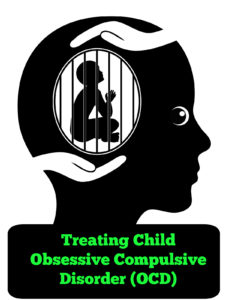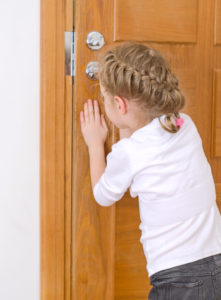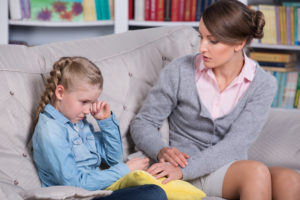Obsessive Compulsive Disorder (OCD) is a disorder characterized by the experience of:
Obsessions: Intrusive, disturbing, recurring intense thoughts or fears
Compulsions: Actions taken to reduce the anxiety and distress of the obsessions being experienced.
For a more in depth discussion of what Childhood OCD is click here.
To take a quiz to help you determine if your child may have OCD click here.

Treating Child OCD
Treating Childhood OCD
OCD is a disorder that waxes and wanes. There may be periods of time when the child is relatively unphased by OCD, and there will likely be times when the OCD symptoms flare up and become problematic.
Professional Treatment of OCD is needed when:
1. A child spends more than an hour a day on compulsive behaviors. At this point it is considered to be greatly impinging on their time and ability to enjoy life.
This may include spending more than an hour on washing rituals, cleaning rituals, or on ordering their belongings in a precise way. Do not however overlook problems like homework taking more than hour longer than it should because of doing and redoing or reading and rechecking. Another possibility could be that more than an hour is spent eating due to performing a ritual while eating. Also consider whether a cumulative excess of an hour is occurring such as an extra 5 minutes tying and retying shoes, then an extra 10 minutes lining up belongings, then an extra 5 minutes returning to check if their lunch is where it should be. If more than an hour a day is consumed by OCD in any form it decreases quality of life.
2. A child is presenting with great emotional distress about the obsessions or the corresponding compulsions.
Often the content of the obsessions is highly fear based. OCD is after all in the family of anxiety disorders so the content of the obsessions is bound to be distressing. If the child is distressed as a parent you will hear concerns, worries, and often tears. While the obsessions are almost certainly distressing the compulsions can also be distressing. For example, the child may not feel that they are capable of performing the ritual satisfactorily or they may experience a great deal of angst that it feels beyond their control to not engage in the behavior.
3. A child is experiencing sleep problems, school problems, social problems, or it is resulting in family problems.
These are secondary problems to the OCD itself and are good indicators of when the experience of OCD is significant enough that it is impairing other areas of life. For instance compulsive rituals may be interfering with the child’s ability to get to bed and fall asleep in a timely manner. If they are too tired or too preoccupied they may not be performing well in school and may not be able to focus on the material to learn effectively. If the family is strained by the symptoms of OCD that also warrants some professional intervention. Maybe one parent believes that the child needs to stop it and follow direction and that the other parent is catering to the child. If this is resulting in family tensions any possible professional involvement is a good idea. The child would likely be well aware of the strain their behaviors are placing on the family placing additional anxiety burden on them.

Help Is Needed Now What!
The best therapist to treat a child with OCD is someone who has experience not only with OCD, but with children.
This is important because children’s reasoning ability is far different from that of adults. Children experience a great deal of magical thinking. It allows them to believe in magic and wonder. It gives them a fantastic imagination. It also makes it more likely that even bizarre fears feel very real to them. Working specifically with a child therapist will help in that they will have had experience with the significant influence that this magical thinking plays in the child’s OCD experience.
Once you have found a therapist to work with your child they will most likely be using cognitive behavioral techniques.
1. Exposure and Response Prevention: In this technique the reinforcement cycle of obsession and compulsion is broken down slowly by incrementally preventing the compulsion. Teaching the child that the obsession will pass without the compulsion.
This is not a “knock it off” approach. The person is exposed to their obsession. They are asked to sit with the anxiety for longer periods of time before engaging in the ritual and challenged to complete only portions of the ritual. As the treatment goes on the goal is to reach a point where the person is able to resist engaging in the compulsion at all or they are able to transition to a milder less intrusive compulsion. The transition is slow and very challenging. The goal is to break the reinforcement cycle that can leave them feeling captive to the OCD.

Child psychologist with a little girl, a child is crying
2. Cognitive Restructuring. In this case there is a lot of discussion about the reality or lack there of in the obsessions being experienced. The therapist questions how this fear would really play out.
If it is something that is impossible like an obsessive fear that if the child does not complete bedtime rituals then they or their parents may die in the night the reality of that as a possibility is discussed. The absence of a relationship between the compulsive behavior and the fear it is intended to address is challenged in order to attempt to weaken the relationship between the obsession and the compulsion.
On the other hand, if the obsession is something like fear of running over someone in the car or people experiencing severe head trauma those things are possible and correlated directly with the acts the child is attributing them to like driving or playing ball. In such a case the therapist would work with the child to discuss what would indicate that such a thing had actually happened. This is done with the intention of reinforcing that the compulsion would not be needed to verify if that had happened. For example how would you know if someone had a severe head injury without having to seek reassurance in a panic, and what sort of impact would have to happen to cause serious head injury? The idea is to get the child to acknowledge that a simple bump is not a source of serious head trauma and that if someone is very badly injured that would be seen in behavior, consciousness, physical injury.

Closeup of a child’s soapy hands
3. Teaching the child to visualize the OCD as an entity outside of themselves. Often the child is told to project their experience of OCD onto a little monster that is trying to trick them. They are encouraged to focus on that little monster and fight it off.
Here the child’s magical thinking is turned on its head. The therapist takes something that is exacerbating the OCD and puts it to work to fight back. This is great when the child is the right age. When they are too young they may not be able to quite do this. When they are too old they can no longer take it as seriously. The concept remains the same though. The idea is to teach them that the OCD is not them and not their thoughts to separate them from who they are and what they really think. This is very useful with bad thought OCD. To read more click here.
I have spoken before about my son’s experience with OCD. When we first tried this technique he was too young to implement the strategy. He kept making the OCD monster into something friendly that he wanted to like and was just not able to push his experience into the character. A year later the strategy was working much better.
4. Possible use of medication. In addition to these strategies there is some benefit shown to the use of SSRI medications. This is based on a link found between the impaired transmission of seratonin in the brain and compulsive behaviors.
SSRI’s are a rather safe group of psychotropic drugs that cause far fewer secondary problems than more commonly used ADHD medications. If the child is old enough the use of SSRI medication can prevent the brain from reuptaking seratonin leaving more of it in the brain to calm the obsessions and compulsions.
This is a difficult decision for a parent to make. If a therapist recommends a psychiatrist consultation take some time to discuss these medications with the therapist and psychiatrist.
To read about how to manage your child’s OCD at home click here.
This is not intended to be instead of professional treatment.
3 reasons to not avoid professional treatment:
1. Research has demonstrated that just talking about obsessions and compulsions does not improve them.
2.We also know that they can be self reinforcing and become more entrenched.
3. The child cannot – “Just Knock it Off!”
However, in the home we have powers to assist the child in many ways. Professionals will not be there every moment and we can do a great deal in the home to assist a child who has OCD click here.

Shannon
Latest posts by Shannon (see all)
- Social Anxiety: More Than Shy - July 10, 2016
- 3 BIG Reasons To Give Children Specific Meaningful Praise - June 27, 2016
- Protecting Children From Sexual Predators: Safety Without Paranoia - June 6, 2016


Leave a Reply